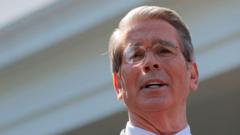The article delves into the recent shifts in Trump's tariff strategy, spotlighting the contrasting roles of Treasury Secretary Scott Bessent and trade advisers Howard Lutnick and Peter Navarro. This internal dynamic shapes the administration's messaging and affects global market reactions.
The Tariff Tug-of-War: Inside Trump's Team Dynamics

The Tariff Tug-of-War: Inside Trump's Team Dynamics
Analyzing the conflicting roles within Trump's economic team, from Bessent's moderate approach to Navarro's hard-line stance.
In the frenetic hours following President Donald Trump's surprising pause on sweeping tariffs on international trade, Treasury Secretary Scott Bessent emerged as the notable face of the administration's decision. Addressing a throng of reporters on April 9th, Bessent, a former hedge fund manager, portrayed the tariff pause as an act of courage, signaling a pivotal moment for the U.S. economy. His supportive presence stood in contrast to the absence of key figures, Commerce Secretary Howard Lutnick and trade adviser Peter Navarro, who are known for their more aggressive trade positions.
Trade policy experts have noted that Bessent's central role illustrates the shifting power within Trump's White House, potentially steering the nation away from escalating tensions in global trade. Longtime industry observers like William Alan Reinsch, formerly of the National Foreign Trade Council, described Bessent as playing the 'good cop' to his colleagues' 'bad cop' roles.
The decision to halt tariff implementation was reportedly influenced by Bessent’s proactive engagement with business leaders, urging Trump to pay attention to concerns about the bond market amid rising economic pressures. This strategy highlights a classic approach to handling Trump: framing the discussion around better alternatives rather than outright contradiction.
Tensions were palpable during the announcement, with notable absences raising questions about internal hierarchies within the administration. For example, U.S. Trade Representative Jamieson Greer's last-minute engagement with Congress illustrated a disconnect and resulted in a tense response from lawmakers once news of the tariff pause broke.
Confusion has often arisen from contradictory statements made by the various figures involved in tariff policy, leading to market fluctuations. As Terry Haines from Pangaea Policy suggests, the strategy of deploying multiple spokespersons with differing messages may create confusion but is a deliberate attempt to engage various audiences.
Looking ahead, analysts predict Bessent could solidify his role as the primary spokesperson for tariff policy, with Lutnick potentially taking the lead in negotiations while other advisors occupy more supporting roles. This more organized structure is hoped to foster greater stability in the markets going forward, which could serve the interests of businesses and investors alike.
Trade policy experts have noted that Bessent's central role illustrates the shifting power within Trump's White House, potentially steering the nation away from escalating tensions in global trade. Longtime industry observers like William Alan Reinsch, formerly of the National Foreign Trade Council, described Bessent as playing the 'good cop' to his colleagues' 'bad cop' roles.
The decision to halt tariff implementation was reportedly influenced by Bessent’s proactive engagement with business leaders, urging Trump to pay attention to concerns about the bond market amid rising economic pressures. This strategy highlights a classic approach to handling Trump: framing the discussion around better alternatives rather than outright contradiction.
Tensions were palpable during the announcement, with notable absences raising questions about internal hierarchies within the administration. For example, U.S. Trade Representative Jamieson Greer's last-minute engagement with Congress illustrated a disconnect and resulted in a tense response from lawmakers once news of the tariff pause broke.
Confusion has often arisen from contradictory statements made by the various figures involved in tariff policy, leading to market fluctuations. As Terry Haines from Pangaea Policy suggests, the strategy of deploying multiple spokespersons with differing messages may create confusion but is a deliberate attempt to engage various audiences.
Looking ahead, analysts predict Bessent could solidify his role as the primary spokesperson for tariff policy, with Lutnick potentially taking the lead in negotiations while other advisors occupy more supporting roles. This more organized structure is hoped to foster greater stability in the markets going forward, which could serve the interests of businesses and investors alike.




















